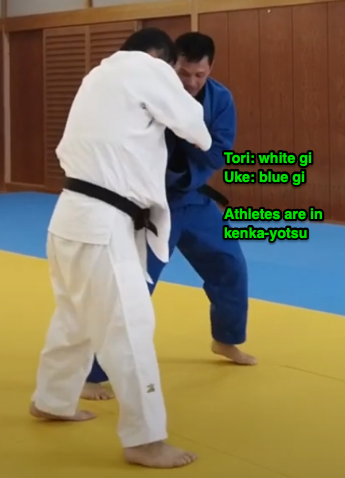Teaching My Teammates: Judo Terms & Concepts (7): O-uchi-gari
This Week’s Quiz
New Terms
O-uchi-gari (大内刈), big inside reap
O (大): big
Uchi (内): inside
Gari (刈): reap
Renzoku-waza (連続技), continuous techniques in the same direction
Renzoku (連続): continuous, connection, linkage
Waza (技): technique
Renraku-waza (連絡技), combination techniques that switch direction
Renraku (連絡): shifting, transfer
Waza (技): technique
Returning Biomechanics Terms
See Week 3 to review as needed.
Base: An abbreviation for “base of support,” all points of contact with the floor and the space between all of them
Center of mass: In oversimplified terms, this is a person’s balance point
Returning Judo Terms
Tori: the grabber, the person performing a throw
Uke: the receiver, the person being thrown
Nage-waza: throwing techniques
Kuzushi: the process of destabilizing uke by pulling or pushing their CoM outside of their base or shrinking their base by forcing at least one foot to disconnect from the ground
O-uchi-gari (大内刈)
English name: big inside reap
Other English names: inside trip
Korean name: 안다리 후리기
English transliteration: andari-hurigi
Classification: ashi-waza
Kuzushi direction: backward-diagonal
O-uchi-gari is one of the most commonly used throws for combination techniques in Judo sport competition. The positioning affords tori a range of follow-up nage-waza in continuing in both the rear and rear-diagonal directions (renzoku-waza) or for the opportunity to change the direction of kuzushi sideward, forward, or forward-diagonal directions (renraku-waza). O-uchi-gari’s broad applicability lies in its utility to:
A: Load uke’s balance onto the lead leg and cut uke’s base out from underneath them powerfully, or
B: Disrupt uke’s base in one of two flavors.
1. Lift uke’s lead leg off of the ground, shrinking their base to the rear leg alone, or,
2. Use a blunt “bunting” force to knock uke’s lead leg backward and force uke to stand “square”–rendering uke vulnerable to nage-waza in virtually any direction
To execute o-uchi-gari, uke’s balance needs to be broken backward and into a diagonal direction. This skews uke’s center of mass into the lead leg–making it heavy. Once this is accomplished, tori immediately steps in deep along uke’s midline, backstopping their trailing leg to advance their base forward. Ideally, tori’s center of mass crashes into uke’s center of mass–knocking them off-balance. Tori then cuts uke’s base out from underneath them from in-between uke’s feet, causing a fall.
Kenka-yotsu
O-uchi-gari is a good direct attack from kenka-yotsu. Tori simply has to apply downward pressure with their grip to skew uke’s center of mass to uke’s lead leg. From there, tori steps to uke’s midline. A backstep may be used to advance tori’s center of mass forward, though variations exist where this is not seen. With uke’s center of mass shifted to their lead leg and tori weighing that side down further with their own weight, tori cuts uke’s base with a reaping action while looking and pressuring in the same direction of the throw. With tori and uke’s centers of mass combined well outside of uke’s base of support, uke falls.
FLUID JUDO JAPAN. (2023, October 8). Effective Ouchi gari master class. YouTube. https://www.youtube.com/watch?v=Iuy5fKlzdck
Ai-yotsu
From ai-yotsu, if tori intends to use o-uchi-gari, they have a problem to address first. If the reaping action of o-uchi is performed from ai-yotsu without preparatory movements to set it up, there is nothing to hit. The task of a tori who favors o-uchi-gari is to do something to get the lead leg out of the way or to move themselves or uke to a better position for o-uchi.
One reasonable option is to attack uke’s lead leg with tori’s lead leg, right leg to right leg, with an attack like ko-uchi-gari. Ko-uchi-gari is an excellent opening attack because it often produces a defensive reaction: stepping backward to a “square” position. From there, entering for renzoku-waza such as o-uchi-gari is made much easier.
Renraku-waza vs. Renzoku-waza
O-uchi-gari can be applied in many contexts. Usually, in sport competition, o-uchi’s purpose is the completion of a takedown. If uke’s defensive reactions do not allow tori to fully accomplish the goal, o-uchi-gari has plenty of potential follow-up attacks in the same backward-diagonal or backward direction (renzoku-waza), or a switch in direction to the side or forward (renraku-waza).
Do you need a good way to remember the difference between renzoku-waza and renraku-waza?
renZoku-waza goes in the Zame direction
renRaku-waza turns aRound in a different direction
It’s dumb. But now you won’t forget it.
Renzoku-waza
A common defense from o-uchi-gari attempt is to step backward outside of the hooking leg. This leaves the opposite leg forward for a follow-up de-ashi-barai in the same direction. If o-uchi is performed from using a drop-knee position, then ko-uchi-gake is a suitable renzoku-waza.
Renraku-waza
One of the most common renraku-waza following o-uchi is uchi-mata. Your leg is already there. Just switch direction from a backward throw to a forward throw. However, you can also use o-uchi in a “bunting” fashion to knock the lead leg out of the way and change directions sideward for a sideward throw like uki-waza.





